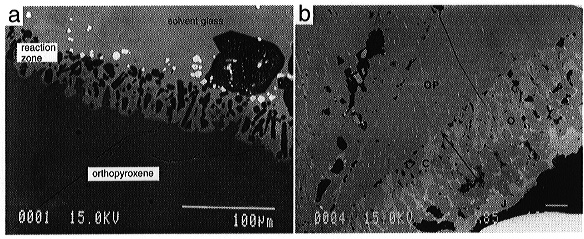

The origin and significance of glass inclusions in spinel peridotite mantle xenoliths have been of great interest to petrologists for more than 25 years. At least nine different and often conflicting hypotheses have been proposed to explain the petrogenesis of these inclusions. In recent years distinctive Si-Al-alkali-rich glass inclusions of highly exotic composition have been noted in xenoliths from localities worldwide. The composition and worldwide distribution of these inclusions led to the suggestion that they represent the quenched remains of a melt that was at least in part responsible for the process of mantle metasomatism.
We have examined the composition of glass inclusions from 35 localities worldwide and we find a bimodal distribution in terms of SiO2 contents. In xenoliths containing > 1% orthopyroxene the glasses are SiO2, Al2O3 and alkali-rich whereas in xenoliths with < 1% orthopyroxene the glasses are SiO2-poor and are generally less alkali-rich. The distribution of glass compositions suggests that orthopyroxene plays a role in the formation of Si-Al-alkali-rich glasses.
To test this hypothesis we have carried out a series of experiments at pressures ranging from one atmosphere to 2.5 GPa to investigate the behaviour of orthopyroxene during dissolution in a Si-undersaturated alkaline silicate melt similar to the glasses in orthopyroxene-poor xenoliths.
At pressures less than 0.5 GPa partially dissolved orthopyroxene is
surrounded by a variably thick reaction zone of olivine, Si-Al-alkali-rich
glass and clinopyroxene. Comparison of these reaction zones to those around
naturally dissolved orthopyroxene crystals shows a remarkable correlation
of texture and phase composition (Fig. 3.2-3). The glass formed in the
reaction
 |
|
b) Naturally dissolved orthopyroxene from a harzburgite xenolith (Gees, West-Eifel Germany). |
zones is less aluminous than those in nature but otherwise there is a close compositional correlation between the experiments and the natural samples. The enrichment of Si in the reaction zones is due to the incongruent breakdown of orthopyroxene to olivine + Si-rich liquid. Clinopyroxene appears in the reaction zones due to inward diffusion of Ca from the solvent melt. Similarly the enrichment in alkalis is due to inward diffusion of these cations from the solvent melt; however, in this case the diffusion is against the chemical potential gradient, (i.e. it is uphill).
At pressures greater than 0.5 GPa the glass produced by orthopyroxene breakdown is much less Si- and alkali-rich and is closer in composition to the solvent than to the natural glasses in orthopyroxene-rich xenoliths. The reaction zones consist mainly of clinopyroxene + glass with trace to minor olivine. At these pressures orthopyroxene no longer breaks down incongruently; thus the glass around dissolving crystals is not as Si-rich as at lower pressure.
These results suggest that Si-Al-alkali-rich glass inclusions in mantle xenoliths might easily form at low pressure due to reaction between orthopyroxene and a Si-poor alkaline melt. In nature such Si-poor melts are normally the medium in which xenoliths are carried to the surface. Thus, we propose that Si-Al-alkali-rich glass inclusions in peridotitic mantle xenoliths are not necessarily the result of a metasomatic processes in the mantle but rather they may be a normal consequence of the transport of xenoliths to the surface.

Tel: +49-(0) 921 55 3700 / 3766, Fax: +49-(0) 921 55 3769, E-mail: bayerisches.geoinstitut(at)uni-bayreuth.de
 Previous page
Previous page